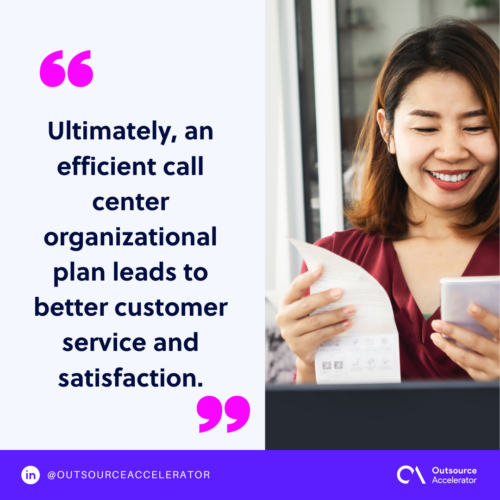Call center organizational structure: A quick breakdown

Call centers are the lifeline of customer service that ensures seamless communication between businesses and clients.
They are centralized offices where customer service representatives handle incoming and outgoing phone calls, typically for customer support, sales, or technical assistance.
A well-defined call center organizational structure is essential to manage a call center’s complex operations effectively.
What is a call center organizational structure?
A call center organizational structure is the framework and hierarchy within a call center that lays down how tasks, responsibilities, and communication channels are organized.
This organizational structure typically consists of managers, supervisors, and team leaders who oversee the operations and ensure that customer inquiries are handled efficiently.
Since agents deal directly with consumers, they are frequently grouped into teams according to their qualifications, areas of specialization, or the kinds of questions they answer.
There may also be support staff, such as trainers, quality analysts, and IT specialists, who assist in various aspects of call center operations.

3 types of call center organizational structures
These structures dictate how tasks are divided, authority is delegated, and communication flows within the call center environment.
Let’s explore three common types of call center organizational structures:
1. Hierarchical structure
The call center is organized top-down, with clear lines of authority and reporting. There are multiple levels of management, from frontline supervisors to middle managers to senior executives.
Each level oversees the one below it and is responsible for making decisions and providing direction. This structure is typical in larger call centers where there is a need for strict supervision and control over operations.
2. Matrix structure
In a call center with a matrix structure, employees report to a functional manager (such as a team leader or supervisor) and a project manager or department head.
This allows for greater flexibility and specialization, as employees can be assigned to different projects or teams based on their skills and expertise. However, it can also lead to clarity and conflicts of priorities if managed effectively.
3. Virtual structure
The call center operates as a network of remote workers connected through technology. A central hub or headquarters may exist, but most employees work from home or in satellite offices.
This structure offers flexibility and cost savings, eliminating the need for a physical location and allowing for a geographically dispersed workforce.
However, it can also present communication, collaboration, and supervision challenges.
Key components of call center organizational structure
By understanding the key components of this structure, businesses can optimize their operations and provide better customer service.
Departments and teams
Call centers typically consist of various departments and teams responsible for specific functions:
- Inbound sales
- Outbound sales
- Customer service
- Technical support
- Quality assurance
- Training team
- Workforce management
Each department or team focuses on its area of expertise to ensure smooth operations and high-quality service delivery.
Reporting structure
A reporting structure outlines the chain of command from frontline agents to supervisors, managers, and executives. Agents report to team supervisors, who report to department managers and up the organizational ladder.
Clear reporting lines facilitate efficient decision-making, problem-solving, and performance management.
Communication channels
Common communication channels include phone calls, emails, instant messaging platforms, and internal communication tools.
Additionally, regular meetings, huddles, and training sessions help disseminate information, address concerns, and foster a sense of teamwork.
Why is call center organization structure important?
When done right, a call center organization plan can:
- It facilitates communication and collaboration among team members.
- With transparent reporting lines and communication channels, employees can quickly seek assistance, share information, and coordinate efforts to resolve customer issues more effectively.
- When everyone knows their role and how it fits into the larger framework, tasks can be completed more quickly and with fewer errors.
Ultimately, an efficient call center organizational plan leads to better customer service and satisfaction.

Best practices for maintaining call center organizational structure
Implementing these best practices can help organizations achieve their goals while fostering a positive work environment for employees:
Clear role definitions
Clear role definitions help employees understand their specific tasks and how they contribute to the organization’s overall goals. This includes defining responsibilities, expectations, and performance metrics for every position within the call center.
Flexibility and adaptability
This means providing employees with the tools, resources, and training they need to adjust to changing circumstances quickly.
Flexibility and adaptability must apply, whether it is for a sudden increase in call volume or the implementation of new technology.
Employee empowerment
Employee empowerment involves giving team members the autonomy to make decisions, solve problems, and take ownership of their work.
Empowered employees are more engaged, motivated, and better equipped to handle the demands of a fast-paced call center environment.
A call center’s organizational structure must be well-organized in order to run smoothly and provide excellent customer service.
By adhering to best practices and continuously adapting to changing circumstances, call centers can maintain a high level of efficiency while meeting the needs of both their clients and customers.







 Independent
Independent




